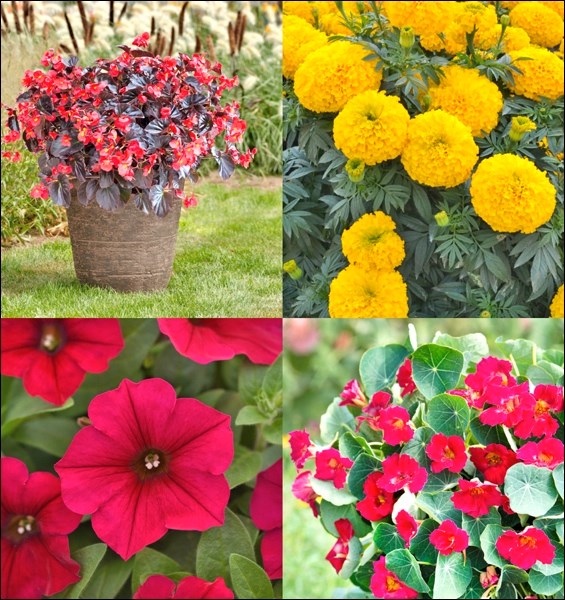When choosing plants for my flower and vegetable gardens, I stick with my usual dependable varieties like ‘Sapphire’ lobelia or ‘Manitoba’ tomato. But why be boring? Every year, there is a veritable plethora (as my high school English teacher would say when trying to impress) of newly introduced cultivars to try as well. Good, because I have options. Bad, because there may be little information on how they’ll perform in Saskatchewan. That’s where All-America Selections (AAS) comes in. Since 1932, this non-profit, independent organization has been testing new ornamental and edible cultivars before they have been released. Initially, only the cultivars that performed well across North America were given the AAS Winner designation. More recently, they’ve recognized regional winners in addition to the national category. This year, there are eight National and Heartland (Prairies and Great Plains) winners from the 2018 trials
Begonia ‘Viking XL Red on Chocolate’ F1 (National): A compact wax begonia (no staking required), it has deep bronze leaves overtopped by masses of contrasting, vibrant red flowers. It tolerates heat, full to partial sun, does well in beds and containers and is pollinator friendly.
Marigold ‘Big Duck Gold’ F1 (National): Do we need another marigold? Yes! This one sports very large golden-yellow ‘plump’ flowers on 11 to 15-inch stems and blooms enthusiastically from summer to frost. Plant in full sun in beds or containers.
Nasturtium ‘Baby Rose’ (Heartland): My grandmother loved nasturtiums and taught me that their leaves and flowers were edible (peppery/spicy) as well as beautiful. Older varieties could be a little rangy. But ‘Baby Rose’ is compact and mounding, with plenty of 2-inch, rose-coloured flowers set off against dark-green leaves. It tolerates full to partial sun, drought, heat, cold, wind and rain. Use the leaves and flowers in salads and smoothies.
Pepper ‘Just Sweet’ F1 (National): A vigorous but sturdy plant (36 inches tall x 15 inches wide) with an abundance of 1 to 3-inch sweet, great tasting, bright shiny-yellow, mini-bell snacking peppers. Plant in full sun from transplants.
Petunia ‘Wave Carmine Velour’ F1 (National): I can remember when the original ‘Purple Wave’ petunia came out. It was a stunner – easy care and free flowering with large purple flowers, trailing up to 3-4 feet. This latest addition to the ‘Wave’ series is all that with the addition of stunning, unique carmine rose blooms, great as a ground cover but especially in hanging baskets and taller containers.
Tomato ‘Fire Fly’ F1 (National): Masses of sweet, bright yellow, 1-inch round tomatoes (ideal as snacks or in salads) are produced 80 days after transplant. An indeterminate plant with good disease-resistance, the vines reach 5-6 feet, so staking/caging is required.
Tomato ‘Red Torch’ F1 (National): A prolific early season tomato (60-70 days from transplants), fruits are 1.5 inches long, red with yellow striping and excellent tasting. The Indeterminate vines will need staking or caging.
Tomato ‘Sparky XSL’ F1 (Heartland): A very sweet and flavourful, red and yellow striped, early-maturing (60-70 days from transplant) cherry tomato, ‘Sparky XSL’ is a great producer. The ‘XSL’ in its name stands for ‘X-tended Shelf Life’, meaning they’ll keep a while on the counter without loosing flavour or quality.
Since these cultivars are so new, they may be difficult to find this year. But take a look at recent winners on the AAS website (www.all-americaselections.org). There are excellent photos, descriptions and information about plant needs, how to grow them as well as their characteristics, garden uses and judges’ comments. I plan on tracking down seed for Canna ‘South Pacific Scarlet’, a winner from 2013.
NOTE: This summer, make time to visit the AAS Display Garden by the north entrance of the Agriculture building on the University of Saskatchewan campus to see recent winners in a garden setting.
Erl gardens in Saskatoon and occasionally tweets about it @ErlSv.
This column is provided courtesy of the Saskatchewan Perennial Society (SPS; saskperennial@hotmail.com ). Check our website (www.saskperennial.ca) or Facebook page (www.facebook.com/saskperennial) for a list of upcoming gardening events.



